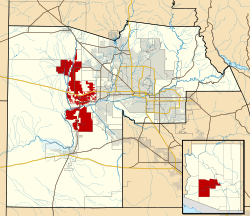Buckeye, Arizona
Town of Buckeye, Arizona | |
|---|---|
 Location in Maricopa County and the state of Arizona | |
| Country | United States |
| State | Arizona |
| Counties | Maricopa |
| Government | |
| • Mayor | Bobby Bryant |
| Area | |
| • Total | 145.8 sq mi (377.5 km2) |
| Population (2005) | |
| • Total | 25,406 |
| • Density | 174.2/sq mi (67.3/km2) |
| Time zone | UTC-7 (MST) |
| Website | http://www.buckeyeaz.gov/ |
Buckeye is a rapidly-growing town in Maricopa County, Arizona, United States in the Phoenix Metropolitan Area. In July 2007, Forbes Magazine ranked Buckeye as the 2nd-fastest growing city in the United States, having had its population grow by nearly 192% between 2000 and 2006 [1].
Geography
Buckeye is located at 33°26′12″N 112°35′36″W / 33.43667°N 112.59333°WInvalid arguments have been passed to the {{#coordinates:}} function (33.436561, -112.593253)Template:GR.
According to the United States Census Bureau, the town has a total area of 377.5 km² (145.8 mi²), all land.
The Town's very large planning area extends, at its widest points, 48 miles from north to south and 24 miles east to west. It borders the planning areas of Wickenburg to the north; Surprise, Glendale, and Goodyear to the east; and Gila Bend to the south. To the west is the unincorporated area known as Tonopah.
Demographics
As of the censusTemplate:GR of 2000, there were 6,537 people, 2,158 households, and 1,624 families residing in the town. The population density was 17.3/km² (44.8/mi²). There were 2,344 housing units at an average density of 6.2/km² (16.1/mi²). The racial makeup of the town was 72.54% White, 3.37% Black or African American, 1.71% Native American, 0.44% Asian, 0.08% Pacific Islander, 19.34% from other races, and 2.52% from two or more races. 36.65% of the population were Hispanic or Latino of any race.
There were 2,158 households out of which 42.8% had children under the age of 18 living with them, 52.7% were married couples living together, 15.7% had a female householder with no husband present, and 24.7% were non-families. 20.7% of all households were made up of individuals and 7.5% had someone living alone who was 65 years of age or older. The average household size was 3.03 and the average family size was 3.47.
In the town the population was spread out with 33.8% under the age of 18, 9.8% from 18 to 24, 28.9% from 25 to 44, 19.3% from 45 to 64, and 8.2% who were 65 years of age or older. The median age was 30 years. For every 100 females there were 101.8 males. For every 100 females age 18 and over, there were 97.7 males.
The median income for a household in the town was $35,383, and the median income for a family was $39,194. Males had a median income of $32,357 versus $24,901 for females. The per capita income for the town was $15,627. About 16.2% of families and 18.8% of the population were below the poverty line, including 27.6% of those under age 18 and 13.3% of those age 65 or over.
Based on the 2005 Maricopa County Census Survey conducted by the U.S. Census Bureau, the 2005 population of Buckeye was estimated to be 25,406. Most recently, Town officials have estimated the mid-2007 population at 42,000.
Neighborhoods
The original Buckeye was built around downtown's main street, Monroe Avenue. The first neighborhoods spread out from Monroe Avenue along First through Tenth streets and other cross streets.
In the mid-twentieth century, the Valencia neighborhood was built just north of downtown, centering upon Baseline Road and Fourth Street.
The biggest waves of development began in the early twenty-first century, with the Town's first master-planned community, Sundance. This neighborhood is located in general vicinity of the intersection of Yuma and Watson roads near Interstate 10. Sundance Towne Center is located here and is the first of several large shopping centers to be built in Buckeye.
Second came Verrado, a master-planned community located along Verrado Way north of Interstate 10. This new urbanist style development is highly regarded around the Phoenix area and across the United States. Nearby is the Buckeye Parkway Center retail development.
A few of the many other master-planned communities currently under development are Tartesso, Sun Valley, Sun City Festival, and Spurlock Ranch, all located along the Sun Valley Parkway north of Interstate 10. The community of WestPark is another growing development northwest of downtown Buckeye, where WestPark Elementary is located.
Many other smaller subdivisions are part of the Town of Buckeye as well.
Due to the amount of land that the Town of Buckeye has annexed or plans to annex (up to 600 square miles), the population may increase to over that of the current population of Phoenix itself. Buckeye is projected to expand to over 380,000 residents by 2030, with some projections giving the city some two million inhabitants by 2050, which would make it the largest suburb in the Phoenix Metropolitan Area and possibly the United States, surpassing Mesa which, by that time, will have been built out completely.
Recreation
A popular recreation destination in Buckeye is the Buckeye Hills Recreation Area. It is located 7 miles south on State Route 85 (at mile marker 144). It contains camping, picnic areas, hiking trails, and a shooting range. The recreation area is part of the Maricopa County Regional Park program, while the shooting range is managed by the Buckeye Sportsman Club.
Media
Buckeye is served by all major Phoenix media in radio, television, and print. There are several more-localized newspapers including the Buckeye Sun, West Valley View, Arizona Republic's Southwest Valley edition, and the Buckeye Valley News.
Famous residents
- Upton Sinclair (author, 1878-1968)
References
1. Forbes Magazine list of the fastest-growing suburbs in the U.S.

